Book clubs are one way to get students together in small groups to discuss a common book that they’re reading. In the past, I’ve avoided book clubs with my middle school students because I convinced myself that they wouldn’t be ready to have a productive conversation without me there. This school year, I decided to get over my insecurity of letting my students have conversations without me and gave them a chance. I was amazed at the conversations sixth grade students were able to have with one another about the books that they’re reading. Here is what I learned about the pieces I would recommend having in place in order to make book clubs a success in your middle school classroom.
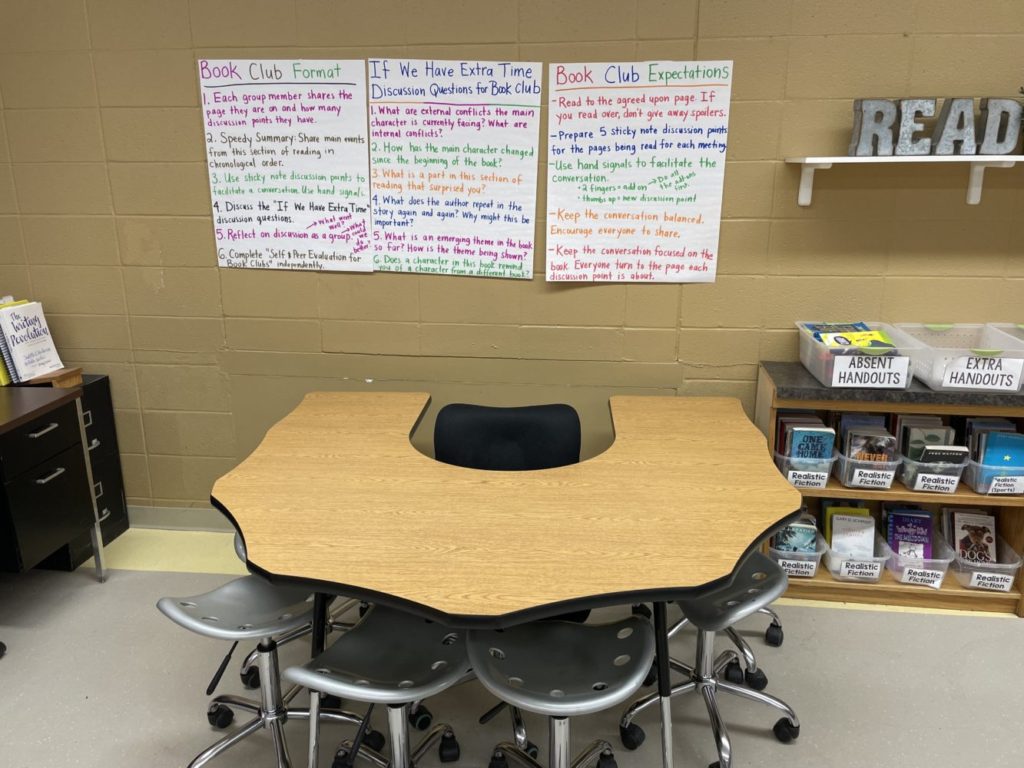
Before I dive into the steps to take, I want to clarify how I define the different small group reading contexts.
-Book Clubs: A class of students is reading 4-5 different books. Students are grouped heterogeneously. Groups of students reading the same book all meet in the classroom at the same time while the teacher walks around the classroom checking in on the different conversations. Students make their own discussion points to bring to the group and complete self and peer evaluations.
-Literature Circles: A class of students is reading 4-5 different books. Students are grouped heterogeneously. One group of students meets each day with the teacher across the week. The teacher can be an outsider observing the conversations and/or jump in and participate in the group’s discussion. Students make their own discussion points, and the teacher evaluates students based on his/her observations.
-Reading Strategy Groups: A class of students is reading 4-5 different books. Students are grouped heterogeneously. One group of students meets each day with the teacher across the week. The teacher works with students on reading strategies and helps students apply reading strategies to their book.
-Guided Reading: A class of students is reading 4-5 different books. Students are grouped homogeneously. One group of students meets each day with the teacher across the week. The teacher prepares a lesson for each group of students based on their book and what each group of students needs as readers.
Tip One for Book Club Implementation: Build Up to Them
I would never recommend starting the year with students reading in a book club format. I highly recommend starting the year with teacher-supported small group reading instruction such as guided reading and/or reading strategy groups and gradually move to literature circles before moving to book clubs. Start the school year out with a plan in mind for what small group reading format you’re going to use with each of your reading units. Below is an example of what this could look like. There are many variations, but I wanted to share an example of how I would go about sketching this out.
Reading Unit One (Realistic Fiction Reading Unit): Reading Strategy Groups
Reading Unit Two (Expository Nonfiction Reading Unit): Guided Reading
Reading Unit Three (Science Fiction/Fantasy Reading Unit): Literature Circles
Reading Unit Four (Memoir Reading Unit): Reading Strategy Groups
Reading Unit Five (Historical Fiction Reading Unit): Literature Circles
Reading Unit Six (Narrative Nonfiction Reading Unit): Book Clubs
Giving students a chance to practice small group discussion in literature circles while you’re present in the discussion and can observe and lift the discussion when necessary is a vital step before jumping into book clubs. If you do not set this opportunity up first, there is a strong chance book clubs will be a complete disaster in your middle school classroom. Additionally, providing students with a daily interactive read aloud where you are stopping and modeling thinking, allowing for turn and talk opportunities, and getting students to write guided responses to text is a great support to building to book clubs.
Tip Two for Book Club Implementation: Teach Students to Write Discussion Points
If students aren’t bringing high quality discussion points to their groups, the conversation won’t be engaging or enjoyable for students. This will have a domino effect and off-task behaviors in the groups will amp up. Modeling how to write engaging discussion points during Interactive Read Aloud works great. Also, using sticky notes and encouraging students to write discussion points as they read versus going back to add them is another strategy I would recommend. Here is the format I teach students for writing discussion points along with an example:
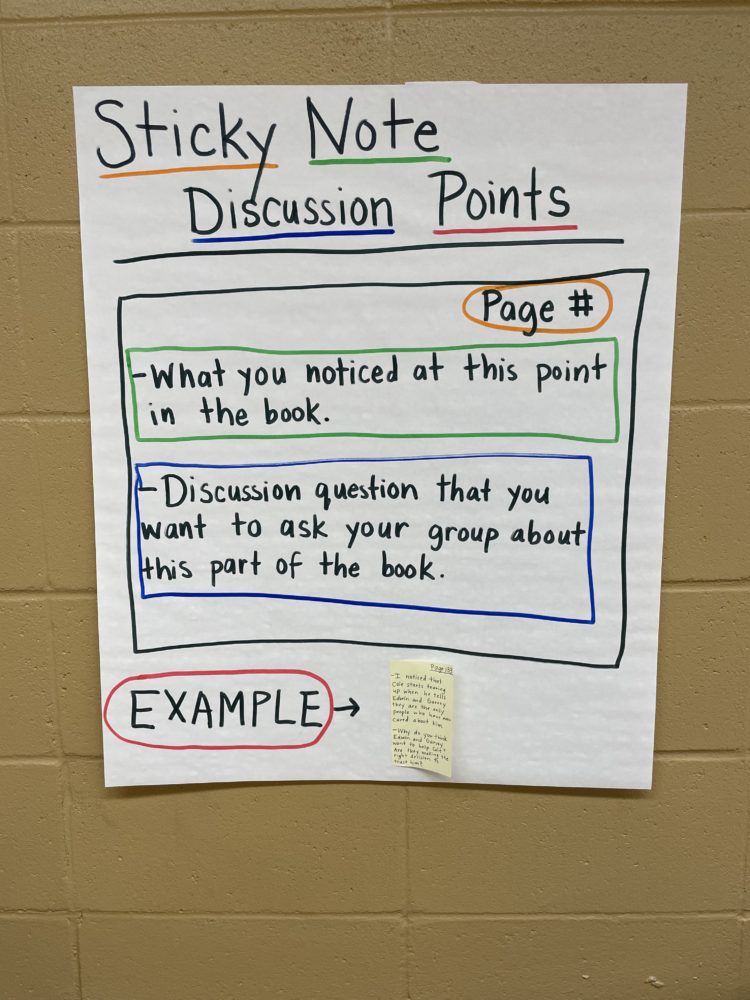
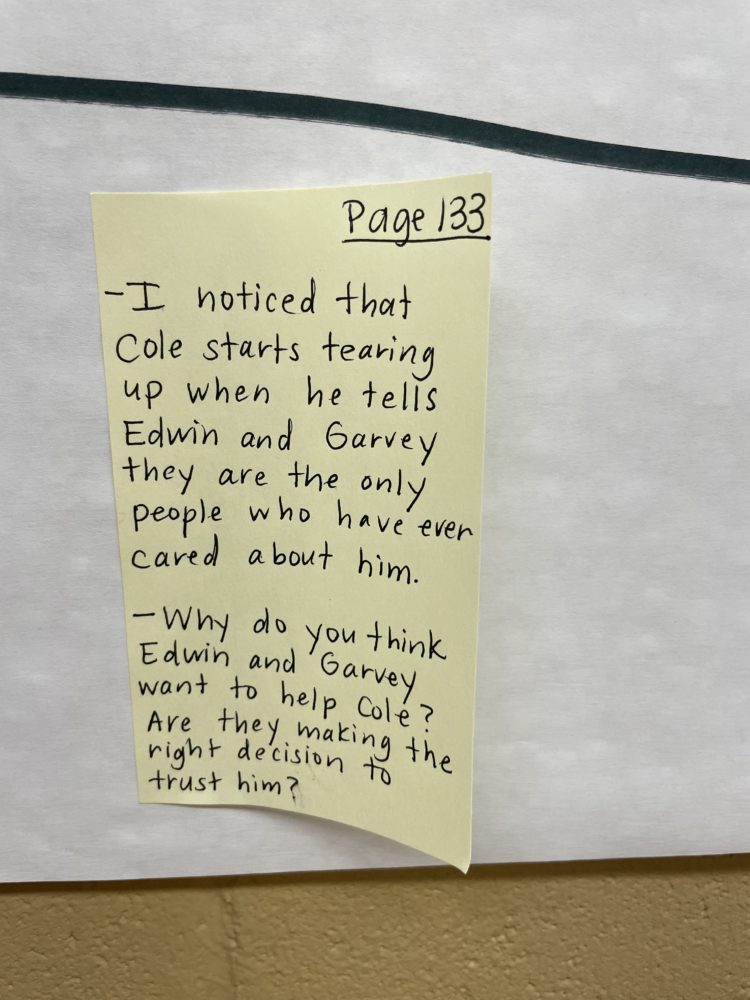
As you can see from the example above, a discussion point has to be more than the observation about that part in the text. It also must include a discussion QUESTION that other students in the group would respond to.
Tip Three for Book Club Implementation: Model the Book Club Format
When you meet with a small group of students in a reading group, you as the teacher have a format in your head that you guide students through. When students meet in book clubs, they also need a format to follow in order for the group time to run smoothly. Below is the anchor chart I post in my classroom as a visual reminder to students about book club format.
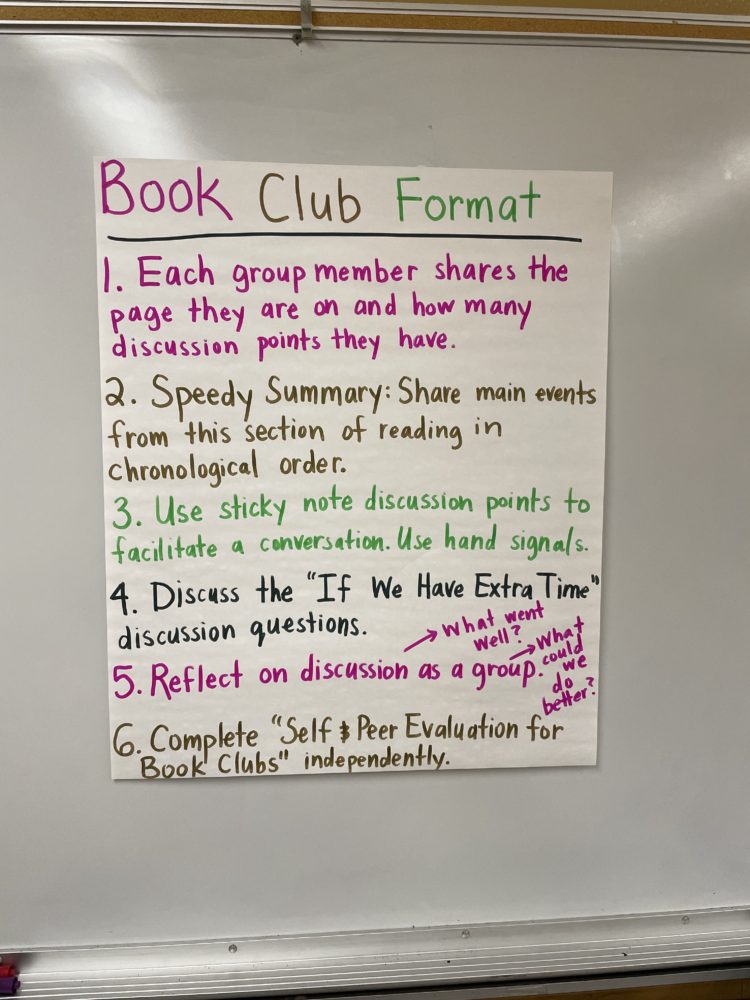
One of my favorite ways to get students to internalize this structure is by having an example group of students go into the middle of the classroom and have all the other students circle around the outside of them as they have a sample book club discussion using our interactive read aloud or a short story. We call this a fishbowl discussion. A fishbowl discussion allows students to see the book club format in action and allows you as the teacher to facilitate a whole class discussion about what students noticed, what went well, and what could go better.
Tip Four for Book Club Implementation: Make Book Club Expectations Clear
After doing a fishbowl discussion to show students a sample book club, it’s a great time to co-construct book club expectations with your class and capture the shared expectations on an anchor chart. Here is an example of the expectations my students came up with:
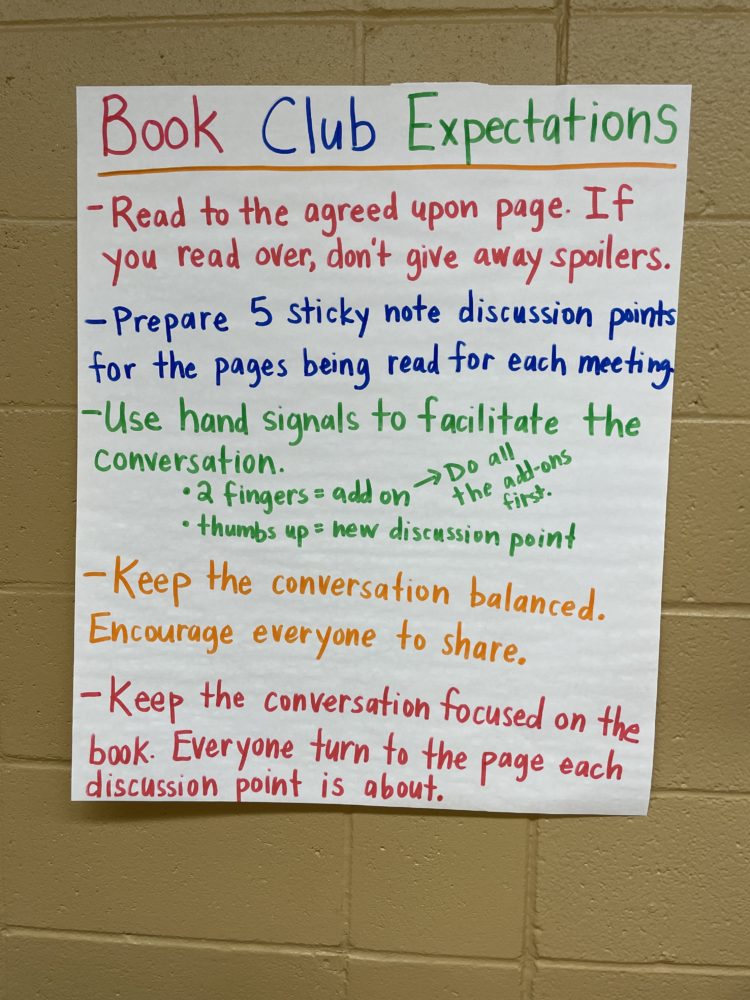
Many of these common expectations originated from what students learned worked for them during literature circles in previous reading units. Before every book club discussion, I review these expectations with students ahead of time.
Tip Five for Book Club Implementation: Give Students Discussion Questions for Extra Time
No matter how prepared students are for book club discussions, some groups may not go into as deep conversations as others. It never fails that there will be one group sitting silently staring at each other while other groups are still chatting away. This is why I recommend having an anchor chart called, “What Can We Discuss If We Have Extra Time?” with questions groups can transition into if they finish talking about their discussion points early. Here is an example of what this anchor chart could look like:
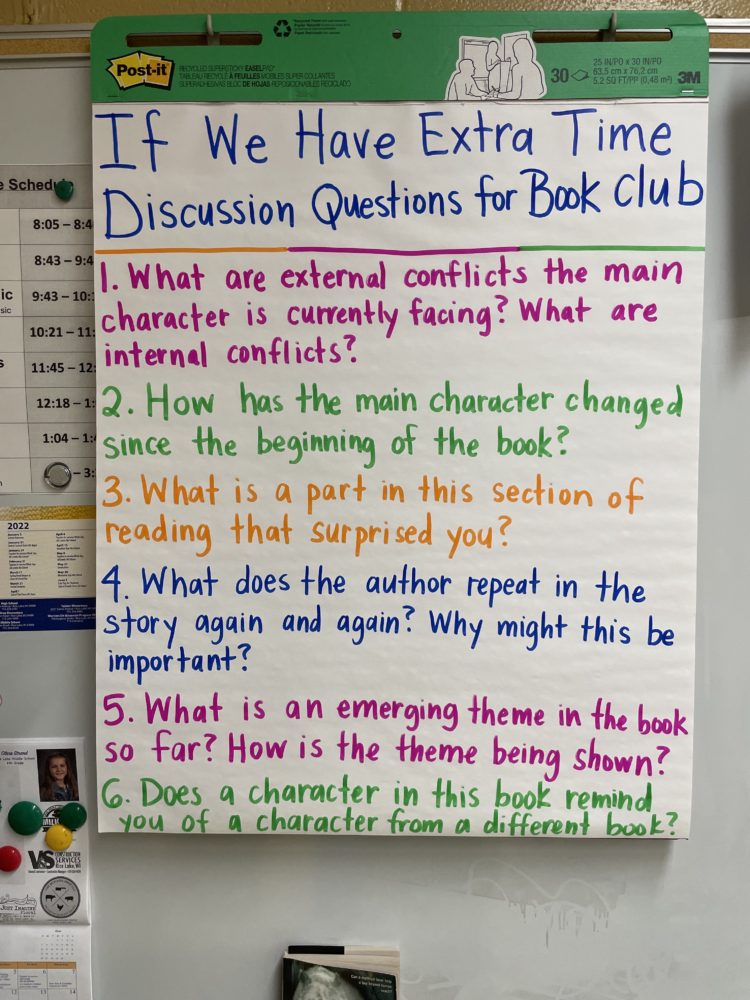
Several of the questions related back to our reading lessons from our current reading unit at the time.
Tip Six for Book Club Implementation: Have Students Self-Evaluate and Peer-Evaluate
Since you can not be in four book club discussions at one time, it is necessary for students to self-evaluate and peer-evaluate how their book club discussion went. Not only does this assessment tool give you a pulse on how students perceived their discussions went, it also gets students to immediately reflect on what went well and what could go better next time their group meets. Below is a picture of the self and peer evaluation I use for book clubs. To grab a free download of this document to use with your students during book clubs, click here.
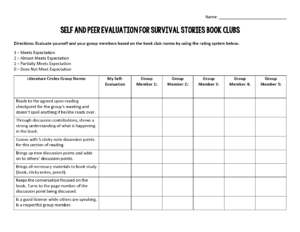
If you decide to implement book clubs into your small group reading instruction line-up this school year, I hope some of these tips help! That moment when you pause and do a 360 in your classroom and realize all book club groups are engaged in productive conversation about books is a pretty amazing one. It doesn’t happen by accident. I hope you experience that this school year.
Kasey





